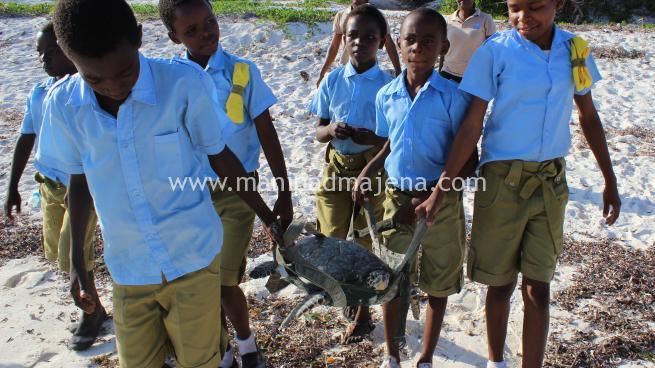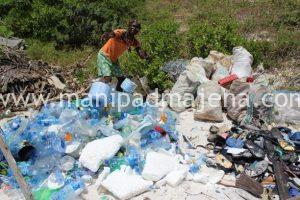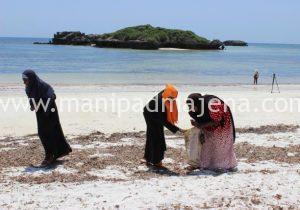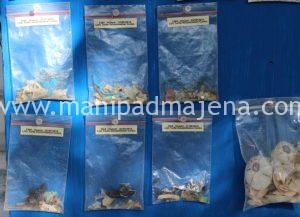
WATAMU, Kenya, Dec 21 (Thomson Reuters Foundation) – Kai, a three-year-old green sea turtle, was released back into the turquoise waters of the Indian Ocean off Kenya’s coast this month.
She had been hospitalised after her guts were blocked with white plastic bags she swallowed, mistaking them for jellyfish, and tiny plastic pieces entangled in the sea grass she eats.
In a bid to clean up Kai’s environment, the villagers of Watamu, who depend on fishing and tourism, joined hands in 2016 with an entrepreneur and a local ocean conservation charity to recycle plastic waste from two marine national parks in eastern Kenya.
In Malindi town, 20 km (12.5 miles) from Watamu and 115 km north of Mombasa city, Sam Ngumba Ngaruiya, 59, is turning plastic waste collected from beaches into green construction materials.
They include six-foot fencing poles used by schools and farms, road signs, paving, roof tiles and recycled plastic containers slowly gaining traction among local people.
Villagers in Watamu, including school children, gather plastic waste from the sea, beaches and households every Friday, a holy day for the Muslim-majority community here.
The poorer among them sell the plastic to Ngaruiya’s company, Regeneration Environmental Services Ltd.
At Watamu’s Blue Lagoon Bay, Gilbert Risiki Ngonyo told the Thomson Reuters Foundation he supplements his irregular earnings from small carpentry and painting jobs with about 3,000 Kenyan shillings ($29.15) a month from selling the salvaged plastic.
The recycling factory pays 10 shillings for a kilogramme of plastic – the equivalent of roughly two 2-litre empty plastic water bottles.
In four hours, collectors can gather 50 kg of plastic, earning 500 shillings ($4.86) – “enough to eat and feed their family for a day”, said Ngaruiya.
Gilbert Risiki Ngonyo segregates plastic waste collected by the community that he will sell to Regeneration Africa, in Watamu village, Kenya, Dec. 2, 2017. Thomson Reuters Foundation/Manipadma Jena
DURABLE PRODUCTS
Locals, many of them women – who work faster than men, according to Ngaruiya – segregate the plastic materials into eight types.
After being machine-chopped into 1-cm flakes, the plastic is washed and dried, before additives like hardeners and sun-blockers are mixed in.
The plastic is heated to melting point to avoid noxious fumes. Then locally sourced river sand, gravel, fibre-glass, sawdust or coconut fibres are added to the hot liquid, and it is poured into moulds to set.
“Basically we are substituting plastic for cement,” said Ngaruiya, a U.S.-trained bio-engineer. Melted plastic absorbs sand, squeezing it as it cools, to become compact and strong, he explained.
“These recycled plastic products can last 200 years,” he said. The negative aspect of plastic waste – that it does not deteriorate or decompose for hundreds of years – becomes a positive when converted into construction materials, he added.
According to the Kenya National Bureau of Statistics, the tourism industry suffered from 2011 to 2015, with coastal marine parks hit the hardest. Visitors to Kilifi County’s Watamu marine park fell by 35 percent, while that in Malindi saw about 40 percent fewer.
The government attributes the drop to security concerns caused by attacks linked to Islamist groups.
Local women who play an active role in the plastic recycling process collect plastic garbage from among dried sea grass at Blue Lagoon Bay in Watamu village, Kenya, Dec. 2, 2017. Thomson Reuters Foundation/Manipadma Jena
DEAD TURTLES
Ben Kithiy, a 24-year-old currency changer in Watamu who makes a living from European and American tourists visiting the fine white sand beaches to snorkel, water ski and windsurf, can think of another reason.
“Floating plastic pieces sticking to the body when you are swimming in these waters makes for a very unpleasant experience,” he said. Even local children who come to clean up the beaches don’t want to swim for that reason, he added.
Every year, between 4.8 million and 12.7 million tonnes of plastic are dumped in the world’s oceans, depending on river flooding, costing some $8 billion, according to a 2017 report from UN Environment.
Kithiy found five foul-smelling dead turtles on his local beach in Blue Lagoon Bay last year. Several others were floating inertly in shallow waters after eating plastic, and would likely have starved to death, he said.
Casper Van De Geer, who manages the Watamu Turtle Watch conservation programme, said that of the 30 to 80 turtles brought in for rehabilitation each year, 15 percent are harmed by plastic.
“Close to half of them die of infection as pieces of hard plastic lodge into nooks and crannies inside the intestine, lacerating it and causing infection,” he said.
Plastic pieces recovered from Hawksbill sea turtle Hogaar, who died of gut infection caused by sharp, hard plastic pieces lodged in his intestine, at the Watamu Turtle Watch rehabilitation centre in Watamu, Kenya, Dec. 2, 2017. Thomson Reuters Foundation/Manipadma Jena
“PERSONAL RESPONSIBILITY”
Since starting production in 2016, Ngaruiya’s factory has recycled 40 to 50 tonnes of plastic waste gathered from Watamu and Malindi. It has a daily capacity of 2 tonnes, but regular orders for recycled materials are yet to come in, despite products being competitively priced, the entrepreneur said.
Ngaruiya has poured in $500,000 of his money – mainly for research. While Kenya banned single-use plastic bags earlier this year, conscious of their devastating impact on wildlife, Ngaruiya’s business has received no financial incentives or subsidies from the government, banks or other funding agencies.
Nicky Parazzi, founder of the non-profit Local Ocean Trust, which runs Watamu Turtle Watch, said the tourism industry, including beach hotels, should contribute more to recycling initiatives.
Ngaruiya’s business has provided the missing link in building a circular economy for plastic, she added.
Ngaruiya said greater awareness is needed at the consumer level. “It’s time to take personal responsibility with one’s own waste, to separate the organics from the plastics, and ensure they reach the recycling centres,” he said.
More such centres are needed along the African coast, with smaller factories alongside, he added.
At the UN Environment Assembly in Nairobi this month, 193 member countries resolved to prevent and significantly reduce marine pollution of all kinds by 2030.
About 40 countries have signed up to a “Clean Seas” campaign launched by UN Environment in January 2017 to introduce government policies for industry to minimise plastic packaging and redesign products, while urging consumers to change their throwaway habits before irreversible damage is done to oceans.
($1 = 102.9000 Kenyan shillings)
Reporting by Manipadma Jena; editing by Megan Rowling.
Please credit the Thomson Reuters Foundation, the charitable arm of Thomson Reuters, that covers humanitarian news, climate change, resilience, women’s rights, trafficking and property rights. Visit http://news.trust.org/climate
*Travel for this story was supported by UN Environment (UNEP).
Featured Image: Marine scouts training with NGO Local Ocean Trust carry green sea turtle Kai to release her into the Indian Ocean, on Short Beach, Watamu, Kenya, Dec. 2, 2017. Thomson Reuters Foundation/Manipadma Jena
Read original article at: Zilient and Reuters: https://www.zilient.org/article/plastic-recycling-aims-cure-turtle-tummy-ache-kenyas-coast



